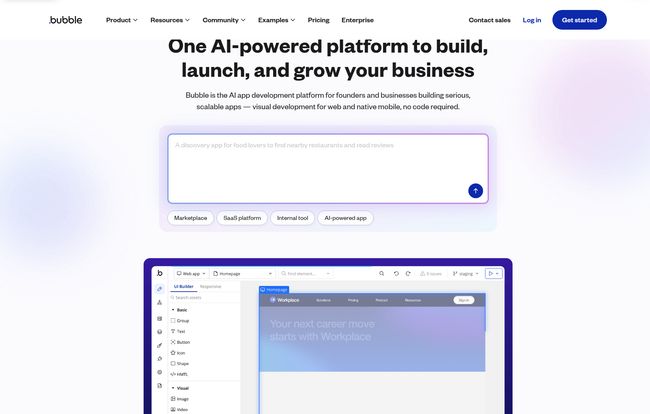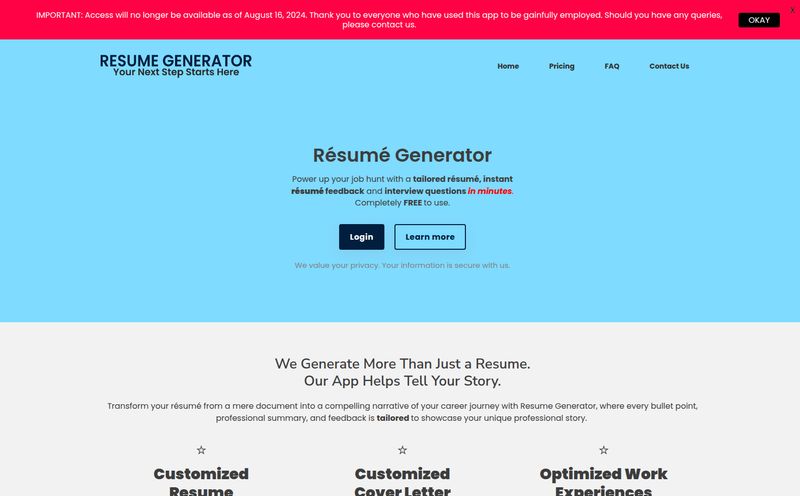How many of us have had a brilliant app idea in the shower, only to have the cold, hard reality of 'I can't code' wash it down the drain? For years, the digital world had a massive gatekeeper: the code itself. You either had to spend months, even years, learning a programming language, or you had to find that mythical 'technical co-founder' who would work for equity and a dream.
I’ve been in that boat. I’ve seen countless great ideas from smart marketing people and entrepreneurs just wither on the vine. But the ground has been shifting under our feet. The whole "no-code" movement has gone from a niche whisper to a full-throated roar. And right in the middle of that beautiful noise is a platform called Bubble.
The promise is intoxicating: build a fully functional web application without writing a single line of code. Sounds too good to be true, right? I thought so too. So, I did what I always do—I rolled up my sleeves and took a good, long look. Here's what I found.
So, What Is This Bubble Thing Anyway?
First off, let's clear up a misconception. Bubble is not just another drag-and-drop website builder like Squarespace or Wix. Those are fantastic for static sites, blogs, and basic storefronts. Bubble is a different beast entirely. It's a visual development platform. Think of it less like a website builder and more like a set of digital LEGOs for creating software.
Instead of typing out commands, functions, and variables, you use a visual editor to design your interface and then connect logical actions. It gives you the power to build things with actual user accounts, databases, and complex workflows. We're talking about building your own Airbnb clone, a social network, or a sophisticated internal tool for your company. It’s wild.
Who Should Be Using Bubble? (Hint: It Might Be You)
The obvious answer is non-technical founders. It's a godsend for entrepreneurs who want to build a Minimum Viable Product (MVP) to test their idea without sinking thousands of dollars into development. But I think its reach is way broader than that.
The Scrappy Founder's Best Friend
Got an idea? You can probably build a working version of it on Bubble in a weekend. Seriously. This speed allows you to get real user feedback fast, which is infinitely more valuable than any business plan. You can pivot, tweak, and iterate without having to file a change request with a dev team. That agility is everything in the early stages.
A Freelancer's Not-So-Secret Weapon
For freelancers and small agencies, Bubble can be a game-changer. You can build custom web apps for clients in a fraction of the time it would take with traditional coding. This means you can take on more complex projects, deliver faster, and potentially increase your profit margins. It's a powerful tool to have in your arsenal.
The Empowered Marketer or Ops Pro
I've seen so many marketing and operations teams hobbled by their reliance on the engineering department for every little tool. Need a custom dashboard? A special calculator for the website? An internal resource portal? Instead of waiting in a 6-month ticket queue, you can just... build it yourself. This is how you make things happen.
A Look Under the Hood: The Bubble Experience
So how does it all come together? Bubble breaks down the app-building process into three main parts. It’s a simple framework, but the depth within each part is pretty impressive.
Designing Your Vision
This is the part that feels most familiar. It's a drag-and-drop interface where you design what your app will look like. They call it "pixel-perfect," and you really do have a ton of control over the layout and styling. It’s also got all the responsive design tools you need to make sure your app looks good on a desktop, tablet, and phone. No excuses for a wonky mobile experience.
Handling the Data
This is where Bubble starts to pull away from simple website builders. Every real app needs a database to store information—user profiles, product listings, customer posts, you name it. Bubble comes with its own fully-featured, built-in database that you configure visually. You can create data types, add fields, and link things together without ever having to write a SQL query. And for the more advanced folks, it plays nice with external APIs, so you can connect your Bubble app to pretty much any other service on the internet.
Crafting the Logic (The Fun Part)
Okay, this is where the magic happens. The "Workflow" tab is where you become a programmer without knowing you're a programmer. You build cause-and-effect chains. "When a user clicks the 'Sign Up' button, create a new user in the database, log the user in, and then navigate them to the dashboard page." You build these logic flows piece by piece, visually. It's incredibly powerful. It does have a learning curve—don't get me wrong. You still have to think logically, but it removes the barrier of syntax and memorizing code.

Visit RemoteFindr & Bubble
Let's Talk Money: Breaking Down Bubble's Pricing
Alright, the all-important question: what's this going to cost me? Bubble's pricing is... interesting. It's based on a concept they call "workload," which is basically a measure of how much server resources your app is using. I actually appreciate this model, it feels more transparent than arbitrary feature gates.
Here’s a quick rundown of their plans:
| Plan | Price (per month) | Best For |
|---|---|---|
| Free | $0 | Just learning and tinkering with the platform. |
| Starter | $29 | Launching your first app and testing the waters. |
| Growth | $119 | Growing your user base and needing more capacity. |
| Team | $349 | Scaling your business with multiple collaborators. |
| Enterprise | Contact for Price | Maximum security, scale, and dedicated support. |
The Free plan is genuinely useful for learning the ropes. For my money, the Growth plan is the sweet spot for any serious project that's starting to get real traction. Also, a quick note: they have a limited-time offer for native mobile app publishing, so if that's your goal, it's worth checking out sooner rather than later.
The Good, The Bad, and The Bubbly: My Honest Take
No tool is a silver bullet. After spending some quality time with Bubble, here are my unfiltered thoughts.
What I Absolutely Love
The sense of empowerment is off the charts. The barrier to bringing an idea to life is just... gone. The speed of development is another huge win. What would take a traditional dev team weeks can be prototyped in a few days. It truly democratizes app creation, and I'm 100% here for that.
Where It Might Burst Your Bubble
Let's be real. If you're trying to build the next Fortnite or a high-frequency stock trading algorithm, Bubble isn't the tool for you. It has its limitations. For extremely complex, custom applications that require very specific code optimizations, you'll eventually hit a wall. The reliance on their visual editor means you lose some of the granular flexibility that pure code offers. There's also a degree of vendor lock-in; you can't just export your Bubble app's code and host it somewhere else. It lives on Bubble. For most people starting out, this isn't a problem, but it's something to be aware of for the long term.
Frequently Asked Questions about Bubble
What in the world is "workload"?
Think of it like gas in a car. It's a collection of metrics (database operations, traffic, etc.) that measure how much server power your app uses. Each plan comes with a certain amount of workload, and you can buy more if you get a sudden surge in users. It's their way of making scaling more predictable.
Can I build a real native mobile app?
Yes, but it's a newer feature. You can build your app in Bubble and then, on their paid plans, you can generate and deploy native versions for both iOS and Android. They even had a special promotion for it, which shows they're serious about this capability.
Is Bubble really free to get started?
Yes. The free plan is quite generous for learning. You can build a full app with it, but to go live on your own custom domain and really launch it to the public, you'll need to upgrade to a paid plan.
How scalable are Bubble apps? Can my app go viral?
Bubble hosts some pretty massive applications. Because the pricing is tied to workload, it's designed to scale with you. If your app goes viral, you'll just need to purchase more workload or upgrade your plan. You won't be held back by the technology itself, at least not for a very, very long time.
Can I connect Bubble to other tools like Mailchimp or Stripe?
Absolutely. This is one of its biggest strengths. Bubble has a robust API Connector that lets you integrate with thousands of other services. You can easily set up payments with Stripe, add users to your email list, pull in data from Google Maps, and so much more.
Do I need to know any code at all?
Nope. Not a lick. However, you do need to learn how to think logically. Building workflows requires you to understand process and cause-and-effect. The platform is the tool, but your brain is still the architect.
Final Thoughts: Should You Try Bubble?
Look, I've been in the digital trenches for a long time, and I've seen a lot of tools come and go. I'm naturally skeptical of anything that promises to revolutionize the world. But Bubble... Bubble is different. It's not a magic wand that instantly creates a perfect app. It's a toolkit. A powerful, accessible, and surprisingly deep toolkit.
If you have an idea—any idea—that you've been sitting on because of the coding barrier, you owe it to yourself to sign up for a free Bubble account. Spend a weekend with it. Follow some tutorials. You might just surprise yourself. You might just build that thing you've been dreaming about. And that, right there, is pretty incredible.



